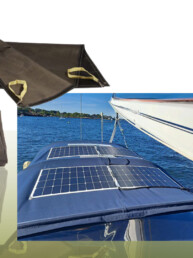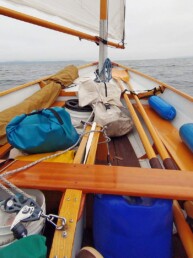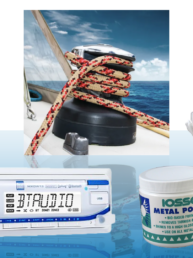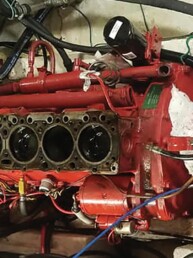This article, by Ray McCormack, originally appeared in the April 2017 issue of 48° North.
You can hardly think about chartering in 2017 without acknowledging that you may be sailing a big cruising catamaran. Even though the Pacific Northwest has been slower to adopt the trend, at many of the world’s charter operations, there are now more multilhulls than monohulls. Most sailors, and certainly most charter companies, will tell you that anyone who can sail a monohull can sail a catamaran. The purpose of this article is not to debate that, but to acknowledge some of the differences that someone who has sailed primarily or exclusively on monohulls may want to keep in mind when setting out on a multihull, whether it’s a big cruising cat, a zippy beach cat, or one of the Farrier designs. With the right boat and conditions, new levels of comfort and fun are possible on multihulls.
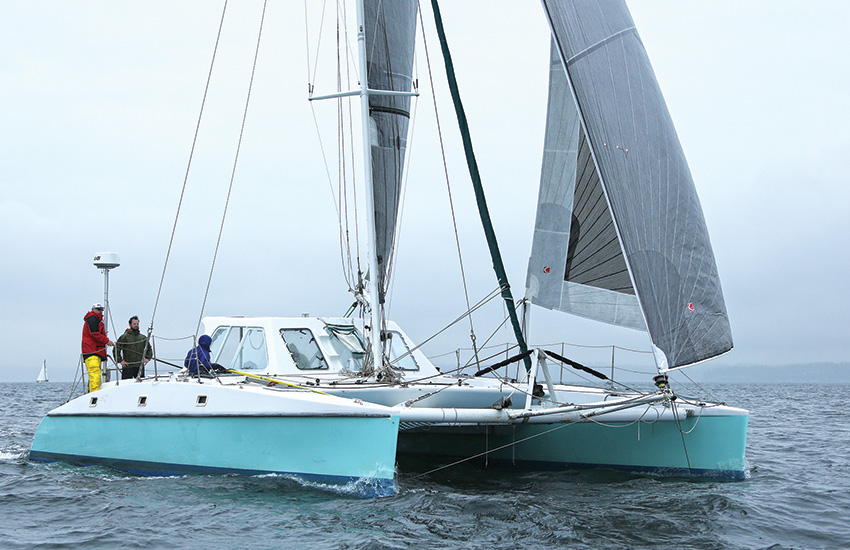
1. SPEED, Usually
Multihulls are known for their speed. They can be faster mainly because they weigh less by not carrying a keel. But many multihulls also posses the ability to fly a hull for less wetted resistance. This, of course, is not common in most cruising cats. In what might seem slightly contradictory, most cats and tris are not very good in light winds, really anything below about 10 knots. In my experience, they are just sticky in the water and don’t perform as well as you might think.
The speed potential brings with it some considerations about apparent wind. You may hear people talk about some performance multihulls that “never sail downwind.” This is meant to convey that you may go so fast that your apparent wind requires sails trimmed as if you’re reaching, or even beating. On an upwind course, apparent wind affect can tend to push the bow down away from the wind. The auxiliary benefit is that the speed of the vessel makes up for lost ground toward a windward destination. Of course downwind it’s a no-brainer, with the speed and apparent wind pushing your bow down even closer to your destination.
2. Maneuvers
Simply put, basic sailing maneuvers are different on multihulls. They are lighter and take longer to turn, so they don’t carry momentum very well. Tacking can be a real challenge. If the multihull is going fast enough, it can make the head-to-wind transition to the new tack. Don’t be afraid to backwind the jib to help get the bow around. In lighter conditions in a cruising context, I’ve known some cat sailors to momentarily turn on an engine to get the boat through the tack.
It’s very easy to get into irons during a failed tack. If this should happen, one just needs to backwind the jib, ease main totally off, keep the helm centered and allow the boat to rotate backwards to gain a bit of steerage. Then you can turn the helm in the direction that allows the back winded jib to tack and fill. Suddenly the boat will start moving forward and you can then sheet the main back in.
Jibes tend to be easier, but one needs to be sure to sheet the main in before performing the jibe. It’s also good to center the traveler. Then ease everything after the jibe.
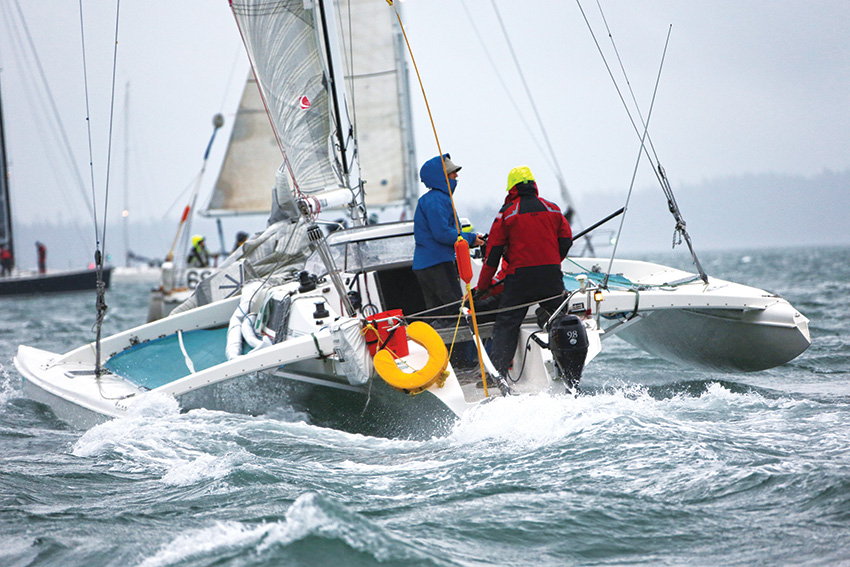
3. Loads
Rigging and sail handling on multihulls is similar to monohulls but also has its point of difference. Multihulls do not heel over the way a monohull would, and heeling in response to a puff is actually altering the angle of attack, spilling a lot of the wind in the sails. Consequently, the loads in the rigging of a multihull are much bigger than a similar sized monohull would experience.
There is a saying in the multihull arena that “at the first moment you think of reefing, you probably should.” Many monohull sailors adhere to a similar philosophy, but it is a die-hard rule in multihulls. Though cruising catamarans generally have an excellent reputation for stability, this principle illustrates potential consequences of the loads. Chafe can also become an issue, and the use of super strong high-tech lines is very important on a mutilhull.
The early move to reduce sail is doubly important on certain points of sail. Be very careful sailing a multihull on a broad reach or a run with full main. It is on these points of sail that a light multihull is most susceptible to a potential capsize. Most cruising multihulls have to see some very severe conditions for this to happen.
Many multihulls make use of the cross beam for sheeting. The main sheet travels almost all the way across the boat. This is why you will sometimes see no vang on the main. What it does mean is you can’t ease the boom that far out. It’s usually a moot point, because they sail faster carrying their apparent wind farther forward. You generally don’t sail dead downwind in a multihull, if running, though, using a preventer on the main is a good idea.
Sail plans on multihulls are built upon the concept of flatter sails, as they usually don’t need extra power, and the increased drag aloft is load with no purpose.
If you do find yourself in heavy weather, it’s good to keep in mind that heaving-to does not really work in a light multihull. The boats end up sailing backwards. A drogue off the bow or stern is usually the answer for a multihull.
4. Motion
The motion of a multihull in any kind of sea state is odd. In monohulls, we are accustomed to how the vessel works her way through swell and chop. Most multihulls make their way through this same sea state with jarring, awkward, unpredictable movement. Many describe it as more of a pitching motion. The light weight, wide platform, and speed of multihulls contributes to this type of motion. Those who sail multihulls swear that you can get used to it, and I would agree with them, after delivering a light catamaran from Hawaii to Shilshole.
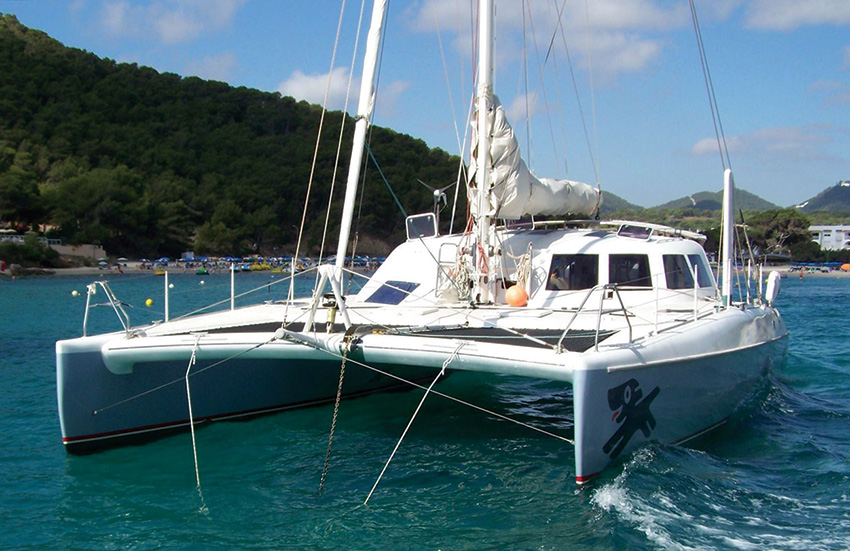
5. Docking and Mooring
One of the biggest differences you will find between monohulls and multihulls will be with docking and mooring. The same lack of mass and momentum that makes multihulls hard to tack can be felt in docking. Additionally, they have much more windage. As a bigger platform, they need more room to maneuver and don’t tend to respond as quickly as monohulls when backing down or turning. However, most cruising catamarans have two power sources, one in each hull. Use these in opposition (one in forward, the other in reverse) to negotiate tight quarters. I’d encourage you to scope out the marina before entering. Venture in at a low speed, just enough to maintain steerage. Visibility can also be a huge challenge, so it’s a good idea to have extra folks up on deck with fenders during docking, ideally on each corner, ready to communicate with the driver and fend off. At anchor, you’ll find that when the wind picks up, a multihull will swing more in the breeze than a monohull. Bridles can help mitigate this, dispersing pressure to wider points on the boat.
Ray McCormack lives in Vancouver, WA, and is a US Coast Guard Licensed captain. He spend his time teaching sailing and working as a delivery captain.
Ray McCormack
Ray McCormack lives in Vancouver, WA, and is a US Coast Guard Licensed captain. He spends his time teaching sailing and working as a delivery captain.

